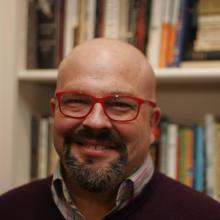
Ricardo Padrón
New Cabell Hall 423
Office Hours: Tuesday / Thursday 2-4PM
Biography
Ricardo Padrón is a Professor of Spanish who studies the literature and culture of the early modern Hispanic world, particularly questions of empire, space, and cartography. He has been teaching at UVA since 1997, but has also held visiting professorships at the University of Pennsylvania, the George Washington University, the Universidade de São Paulo, and the Ecole des Hautes Etudes en Sciences Sociales. His most recent monograph, The Indies of the Setting Sun: How Early Modern Spain Mapped the Far East as the Transpacific West (Chicago 2020) questions established narratives about the "invention of America" by exploring the ways in which the Spanish geopolitical imaginary included East and Southeast Asia in its evolving understanding of "the Indies." His research for this book has taken him to China, Japan, and the Philippines, and has been sponsored by U.Va’s Center for Global Inquiry and Innovation, Arts & Sciences at U.Va, and the National Endowment for the Humanities. It earned Honorable Mention for the Modern Language Association's Katherine Signer Kovacs Prize. Prof. Padrón has also published on early modern poetry, historiography, and material culture, as well as on the mapping of imaginary worlds in modern times. He is an active member of the Renaissance Society of America, and is currently serving as the organization's representative to the American Council of Learned Societies. He is also the founding president of The Society for Early Transpacific Studies, and Director of Graduate Studies in Spanish at UVA.
Education
Ph.D., Romance Languages and Literatures, Harvard
M.A., Romance Languages and Literatures, Harvard
A.M., Divinity, Chicago
B.A., Political and Social Thought, University of Virginia
Publications
Books
The Spanish Pacific, 1521-1815, Volume 2, co-edited with Christina Lee (Amsterdam University Press, 2024).
The Indies of the Setting Sun: How Early Modern Spain Mapped the Far East as the Transpacific West (University of Chicago Press, 2020).
The Spanish Pacific, 1521-1815: A Reader of Primary Sources in English Translation, co-edited with Christinia Lee (Amsterdam University Press, 2020)
The Spacious Word: Cartography, Literature, and Empire in Early Modern Spain (University of Chicago Press, 2004)
Recent Articles
- “The Story of the Stone: The Transpacific Travels of Mexican Obsidian in the Sixteenth Century,” in Res: Anthropology and Aesthetics, Forthcoming.10,025 words.
- “How to Discover the Pacific in the Twenty-First Century: Methods for Mapping a Forgotten Imperial Geography,” in Rethinking Transpacific Ties: Asia and Latin America, edited by Leo Garofalo and Ana Rodríguez Rodríguez. Forthcoming. 10,676 words.
- Padrón, Ricardo. “Multitudo Insularum: The Rhetoric of Numbers and the Mapping of the Indies.” In Far From the Truth: Distance, Information, and Credibility in the Early Modern World, edited by Johannes Müller and Michiel van Groesen, 106–27. The Hakluyt Society Studies in the History of Travel. London: Routledge, 2024. https://www.taylorfrancis.com/books/9781003367079. 7,965 words.
- “Race, Empire, and Cartography,” with Risa Puelo, in Seeing Race Before Race: Visual Culture and the Racial Matrix in the Premodern World, edited by Lia Markey and Noemie Ndiaye. Chicago: Arizona Center for Medieval and Renaissance Studies, 2023. 9,678 words. This edited volume received the 2024 Association of American Publishers’ PROSE Award in the ‘Art Exhibitions’ category.
- “The Confusions of Idolatry: Rodrigo Vivero, Japan, and the Hapsburg Monarchy" Revista de estudios hispánicos, 55:1 (2021), 117-138. 8131 words.
- "América, las Indias, y el Pacífico, siglo XVI," in Prieto, Mercedes, and Luis Alfredo Briceño, eds. Etnohistoria: Miradas Contectadas y Renovadas. Quito: FLACSO-Sede Ecuador, 2021. 124-57. 11,360 words.